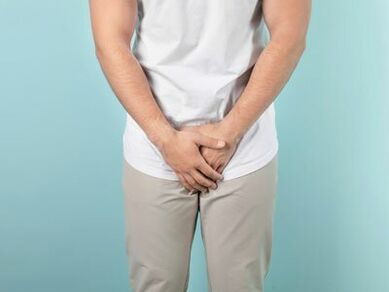
Discharges from the Male Genital Organs: Normal and Abnormal
- Urine.Light yellow liquid with a faint characteristic odor. Usually, it is released in batches during a controlled action. One of the diseases of the urinary system is urinary incontinence. In this case, urine is either released periodically and uncontrolled in different volumes, or it is released constantly but drop by drop. This symptom indicates a disorder in the urinary system.
- Pre-ejaculation.Colorless, odorless mucus secreted during sexual and erotic stimulation (during masturbation, moderate erotic stimulation, during sexual intercourse, and before ejaculation). Produced by Cooper's glands located next to the urethra. Pre-ejaculation fluid acts as a natural lubricant and deacidifying agent for the male urethra and female reproductive tract to increase sperm motility. What's different from normal is the massive release of pre-ejaculation.
- Prostate secrets.Off-white milky liquid. It is produced by the prostate and is part of the semen, ensuring the normal fertilization ability of sperm. The release of prostatic fluid outside of ejaculation is called prostatic leakage. Typically, secretions can be released during mechanical action (massage) and straining (during defecation) on the gland. Other forms of prostatic leakage indicate glandular dysfunction.
- Ejaculation.Gray-white mucus with a special odor. Its ingredients are complex. Typically, it is released during male orgasm and ejaculation. Physiological sex is considered the release of ejaculate during intercourse and wet dreams (during abstinence in adolescent and adult males) and during intense sexual and sexual stimulation. Isolated cases of ejaculation during sleep due to startle or physical stress are not considered pathological. All other options for sperm release are reasons to consult a doctor.

Pathological discharge from male urethra
- slime.Profuse secretion of mucus is accompanied by inflammatory changes in the urethra. Discharge may be clear, cloudy, or white.
- Mucopurulent discharge.Discharge of pus from the urethra indicates an infectious process. Excessive pathological discharge can cause a sticky and uncomfortable feeling. Sparse – Found only as traces on linen.
- White discharge.White mucus discharge in men is accompanied by non-specific infections and inflammatory processes. Candidiasis is often accompanied by a thick, cheese-like discharge.
- Gray secret.Gray fluid or mucous discharge may be sperm or prostate secretions flowing outside of physiological conditions. But it is better to consult a specialist to rule out pathological causes.
- Damn question.Brown or pink urine, scarlet or clear mucus streaked with blood, and the presence of blood in semen are all signs of structural changes in the genitourinary organs, which may be caused by injury, severe inflammation, or the development of tumors.
- Foul-smelling discharge.Discharge with an unpleasant odor is characteristic of a genital infection. A specific rancid or putrid odor coming from the genitals should prompt medical attention.
What other symptoms might there be?
- Difficulty urinating (frequent urgency, difficulty urinating, feeling of incomplete urination, burning and stinging during urination);
- Changes in urine parameters (abnormal color, odor, foam, flaky sediment, etc. );
- lower abdominal pain;
- Toxic syndrome (weakness, lethargy, apathy, etc. );
- Decreased libido;
- erectile dysfunction;
- Ejaculation problems (premature ejaculation, difficulty reaching orgasm, changes in sperm characteristics, etc. );
- Soreness in the lower abdomen, perineum, or scrotum.

- Pain and burning sensation during urination;
- Itching in the groin;
- rash, genital ulcers;
- An unpleasant odor emanates from the genitals;
- Decreased libido;
- Pelvic pain;
- Increased body temperature, drowsiness, weakness, etc.
What should I do if there is discharge from the male urethra?
- Talk to the patient.The doctor conducts an investigation, identifies the chief complaint and collects medical records. Honesty when communicating with experts is extremely important in determining further inspection strategies.
- Physical examination.A urologist visually assesses the condition of the reproductive organs and mucous membranes. A digital rectal examination can initially determine the size, structure, and tenderness of the prostate.
- diagnosis.A urologist takes a smear from the urethra, which is then sent for microscopic analysis. Depending on the indication, patients are diagnosed with additional laboratory methods (blood tests, urine tests, and PCR tests for sexually transmitted infections) and instruments (ultrasound of pelvic organs, prostate, etc. ).
Treatment of male discharge
- Pharmacological treatment uses antibacterial, antiviral, and antiprotozoal drugs, as well as immunomodulators and anti-inflammatory drugs.
- Physical therapy is used in the comprehensive treatment of chronic infectious and inflammatory diseases.
- Surgical approach - mainly minimally invasive surgery to eliminate structural changes, proliferative processes and tumors.
Prevent male discharge
- Follow personal hygiene rules;
- Wear underwear made of natural fabrics;
- Selectivity in choosing a partner;
- Use barrier contraception during casual sex;
- Avoid hypothermia;
- engage in regular physical activity;
- Balanced diet;
- Say no to bad habits;
- Annual preventive exams with a urologist.

















































































